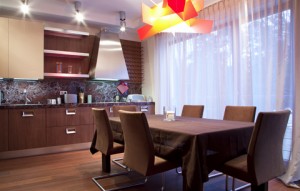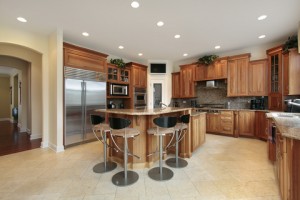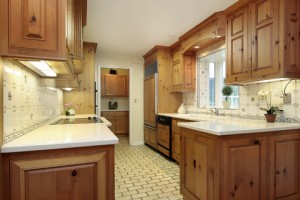Kitchen Lighting Ideas: Using Both Design and Fixtures For a Perfect Look
Coming up with the best kitchen lighting ideas is a matter of understanding how all the elements of kitchen lighting work together.
Once upon a time, “kitchen lighting ideas” and even “kitchen design” would have sounded bizarre. Kitchens were regarded as a purely functional space, in much the same way that we usually consider our laundry rooms or furnace rooms. Guests were entertained in the dining rooms and parlor, while the kitchen was simply a place for preparing food. However, this is no longer the case. The kitchen has expanded into the rest of the home. Today, guests enjoy helping hosts prepare, and the preparation itself has become a kind of social activity. The breakfast table has become an important part of most families’ rituals, and often all meals are eaten right inside the kitchen. Finally, the introduction of open-concept homes means that the kitchen is often visible from the traditional entertaining rooms.
This makes it vital to have the right kitchen lighting ideas. Like any functional area of the home, the kitchen is already tricky to light correctly. Add to this the need to make the kitchen an inviting and comfortable space, and it becomes a true puzzle. Fortunately, working through the puzzle is really a matter of working through all the different demands that we place on our kitchens.
The Different Uses of the Kitchen
The primary difficulty in lighting the kitchen is that the kitchen actually has a number of different areas that have different task lighting requirements. When developing kitchen lighting ideas, it is important to start with lighting for these tasks and then to fill in the light between those functional spaces.Food Preparation
In order to determine good kitchen lighting ideas for our workspace, we must note note that there are different steps in food preparation that require different sorts of lighting. The cutting of food is perhaps the most dangerous part of food preparation, and requires exceptionally strong task light. Therefore, there should be at least one part of your counter that has very bright light.
On the other hand, the actual cooking of food needs not so much bright light as the correct color light. Many hooded stoves come with their own inbuilt halogen or incandescent lamps. This is actually a mistake. Halogen and incandescent lamps are pink light, and distort the color of your food, creating possible mistakes in determining how well food has been cooked. Instead, find white fluorescent or LED light fixtures and use them when cooking.
Eating
Eating at the breakfast table is an important part of the family ritual that you will need to think about when developing kitchen lighting ideas. Eating itself must be accommodated by the proper use of lighting. While it is nowhere near as intricate a task as preparing food, eating food requires its own lighting solutions.
First, the food itself must be properly lit. This can actually be trickier than you might think. Don’t solely light the table from directly above. The reason is that the glare from the light will bounce off of the table and off of people’s plates and cutlery. This “reflected glare” can make eating a subtly uncomfortable experience. Instead, include some light for the table from the sides, using wall lighting and some of the light overflow from the cooking area.Second, the people must be properly lit. Eating is usually a social activity, so considerations from social areas of the home are appropriate. People look best under pink light, as it brings out their skin tones, so use either incandescent lights or other lights colored like incandescent lights. Make sure that light hits the table from every direction, or half of your family or guests will be in shadow.
Cleaning
The kitchen is both an especially difficult and an especially important room to clean. It is difficult to keep clean because food has a habit of escaping in various ways. Even when it doesn’t, smoke gradually builds a slight film on everything. It is important to keep clean because dirt can get into food and cause disease more easily in the kitchen than anywhere else.
What this means when developing kitchen lighting ideas is that the kitchen must be well lit everywhere. Any spots in the kitchen that are not well lit can very easily get food residue in them, and you wouldn’t even notice. Instead, ensure that every spot in the food preparation area is directly struck by the beam of light from at least one bulb.
An especially important area to have strong light is at the dish-washing area. It is very easy to leave food residue on dishes, even if you have an electric dishwasher. Instead, make sure that it is easy for people to see whether or not dishes are really clean before they put them away.
Different Types of Kitchen Lighting
There are a number of different types of kitchen lighting, and the best kitchen lighting ideas will make use of multiple sources and types of lighting. In fact, using only one type of source of light can cause some serious difficulties.
Ceiling Lighting
The most common way of lighting a kitchen is to use kitchen ceiling lighting of one sort or another to light the kitchen space. In fact, many kitchens only use ceiling lighting, which is a very serious (and even potentially dangerous) mistake.
Using only ceiling lighting creates the situation that people block their own task lighting when they stand at the kitchen counter. For example, if you are cutting food, you’ll find that there is a shadow (your own shadow!) over all of your food. Next time you see someone try to cut vegetables under only ceiling light, watch them carefully. You’ll notice that they are dodging and weaving like a prize fighter, trying to get out of the way of their own shadow.Recessed and pendant lighting cause further problems when they are the only source of light in a kitchen. Recessed lighting fixtures, when used exclusively, create very harsh shadows on people’s faces, especially below their noses and on their necks. It accentuates wrinkles and makes people look a decade older.
Kitchen pendant lighting, on the other hand, can create the problem of the dreaded “glare bomb”. When a single pendant light is used (or when any single source is used for an entire room), that light source is necessarily too bright. It draws too much attention to itself, is literally blinding and dims the entire room by forcing people’s irises to contract.
There’s nothing wrong with including ceiling lighting fixtures in your kitchen lighting ideas. However, it should never be the sole source of lighting for a room, especially in the kitchen where it actually interferes with performing tasks.
Under-Cabinet Lighting
Under-kitchen-cabinet lighting is widely considered to be one of the best kitchen lighting ideas. It provides both excellent task lighting as well as an attractive ambient light for the rest of the room.
Under-cabinet lighting is light tucked under the cabinets that either directly lights the countertop (and whatever is on the countertop, like food) or is reflected off of the back wall, providing ambient light for the entire counter area. Which you choose depends on the reflectivity of your countertop. If your countertop is reflective, you should shine the light onto your back wall, while if it is not reflective, you can shine the light directly on the counter top.Under-cabinet lighting also has the advantage that it hides the lights from the eyes, preventing glare, an important part of all good kitchen lighting ideas. With the lights tucked under the countertop, anyone taller than the countertop won’t see the light sources directly. Note that someone eating food at a table that is lower than the countertop might still be able to see the bulb directly, so be careful you are not casting glare on your breakfast table. When cabinets are unavailable near a given countertop, other types of lighting such as kitchen track lighting must be used.
Ambient Lighting
Ambient lighting is diffuse lighting that is created by bouncing light off of walls and ceilings, rather than shining it into the room directly. It is a very important part of most kitchen lighting ideas, because it is ultimately the part of the lighting that makes people, as opposed to food, look good.
Numerous sources can provide ambient lighting. For instance, you could put lights on top of your counters that shine the light onto the walls and ceiling, providing an overall pleasant light to the food preparation area. In the eating area, you could use wall lights with opaque shades that shine light onto the wall behind them. You could also use pendant lights, also with opaque shades, to shine light onto the ceiling, giving the room an overall ambiance.
Use warm (i.e. incandescent or a similarly colored bulb) light for this ambient light. Its primary function is to fill in the areas between the task lights so as to light people’s faces. If you are bouncing the light off of your walls, note that the color of the walls will also affect the color of the light, so choose a color with this shift in mind.
Putting It All Together
Good kitchen lighting ideas will depend on taking account both of the functional uses and the social needs of the kitchen:
- Use bright light for cutting and white light for cooking.
- Light the entire food preparation area, especially the dish washing area.
- Use under-cabinet lighting as your primary source of task lighting, if possible.
- Have sufficient warm, ambient light that flatters your guests and family.
With all of these steps taken, your will be able to create a kitchen lighting layout that is both functional and welcoming.
More Kitchen Lighting Design Articles:
Kitchen Lighting Layout: Creating the Best Lighting Plan for Your Kitchen
Putting together a kitchen lighting layout is a matter of layering your various lighting needs into a productive and attractive whole.
Kitchen Track Lighting: Planning Your Track Lighting Layout
Kitchen track lighting helps both with your kitchen’s task and decorative lighting.
Kitchen Ceiling Lighting: Integrating Your Kitchen Space
Kitchen ceiling lighting provides excellent and well-needed ambient and accent lighting in your kitchen.
Under Kitchen Cabinet Lighting: Using the Best Task Lighting Fixtures
Under kitchen cabinet lighting provides the highest-quality task lighting for your kitchen counter.
Kitchen Pendant Lighting: Attractive Ambient Lighting Fixtures
Kitchen pendant lighting provides multi-directional ambient lighting while providing attractive fixtures.



